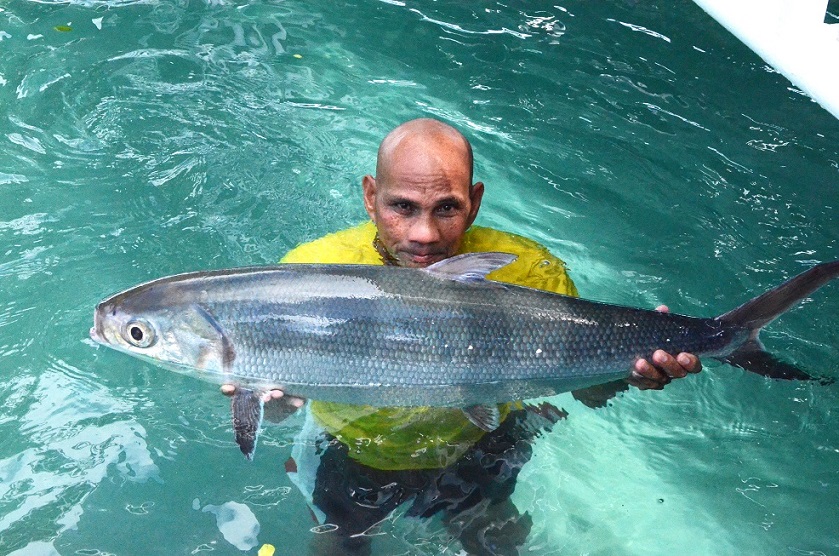
Julius Jimenez, a technician of the Southeast Asian Fisheries Development Center Aquaculture Department (AQD) in Tigbauan, Iloilo carries one of over 200 sabalo or milkfish breeder, the biggest being 1.2 meters long and 18.5 kilograms in weight. Photo by SEAFDEC/AQD.
TIGBAUAN, Iloilo – The public is assured of a stable supply of bangus all-year round, thanks to the technology that the Southeast Asian Fisheries Development Center (SEAFDEC) Aquaculture Department (AQD) based here has developed and continues to improve that enables mother bangus to produce fry at the mature age 35.
“Fry from SEAFDEC/AQD are said to be of the best quality, eliminating the risk of deformations which is the usual issue with milkfish fry,” says newly-appointed SEAFDEC/AQD Chief Dan Baliao who aims to “continue the organization’s legacy of providing technical assistance to interested stakeholders through information dissemination and training.”
SEAFDEC has over 200 milkfish (Chanos chanos) breeders locally known as sabalo or mother bangus, the result of 40 years of research and development. They serve as alternative sources of milkfish fry in the country.
The groundbreaking maturation and natural spawning of captive milkfish back in 1980 and the completion of the milkfish life cycle in captivity back in 1983, have resulted into the hatcheries of the Southeast Asian Fisheries Development Center producing an average of 60 million milkfish eggs per spawning season which is from March to November with the oldest sabalo still producing quality fry at the age of 35.
According to SEAFDEC/AQD’s research, milkfish in captivity attain sexual maturity in three to five years at about 3 to 5 kilograms and continue to spawn and produce good quality eggs and larvae for years as in the case of the 35-year-old sabalos.
Baliao, who assumed office last Sept. 7, 2017 and will serve for two years, adds that SEAFDEC/AQD is the first in the world to actually come up with captive milkfish broodstock which explains why some sabalo are 35 years old with some weighing as much as 18.5 kilograms.
With the development of milkfish hatchery technology at SEAFDEC/AQD, most fry in Asia are now sourced from privately-operated hatcheries.
Fry buyers
Most buyers of SEAFDEC/AQD’s bangus fry are from Iloilo and other places in the Visayas although it also gets orders nationwide. It cannot accommodate orders from overseas.
The price of the bangus fry at SEAFDEC/AQD is pegged at 30 centavos apiece, while private hatcheries sell at 25 centavos to 45 centavos. SEAFDEC/AQD says that they have buyers who buy as much as 300,000 pieces per order.
Milkfish is an important food fish traditionally cultured in the Philippines, Indonesia and Taiwan and is available year-round in the Philippines with fry normally coming from the wild, usually along sandy beaches, using fine-mesh nets. These are then reared in nurseries before release into ponds or cages for grow-out until they reach a marketable size of 300 to 500 grams.
SEAFDEC’s Aquaculture says that the disadvantage of harvesting wild bangus fry for commercial purposes is the seasonal variations in their availability and the depletion of the wild milkfish population, evident now in the shortage of wild-caught fry.
SEAFDEC at the forefront of bangus research
SEAFDEC AQD has sought to develop the technology for a sustainable, year-round source of quality milkfish fry and help fish farmers adopt the techniques as part of its mandate of focusing on aquaculture research and development.
Established in 1967, SEAFDEC based in Tigbauan is covered by a regional treaty to promote fisheries development in Southeast Asia with the following member-countries: Brunei Darussalam, Cambodia, Indonesia, Japan, Lao PDR, Malaysia, Myanmar, Philippines, Singapore, Thailand, and Viet Nam.
The challenge on the shortage of milkfish fry has been remedied by the development of milkfish hatchery technology by SEAFDEC since 1983 and its successful adoption in private hatcheries since 1991.
At present, milkfish research is on further improving the reproductive performance of breeders by feeding them with fortified diets and broodstock selection using molecular markers.
“Molecular markers allow us to look at the genetic profile of milkfish at the DNA level to screen for better reproductive efficiency and possibly better growth rate, survival, and disease or stress tolerance,” says Maria Rowena Eguia, a scientist at SEAFDEC specializing in genetics.
Food security vis-à-vis climate change
“Further production of quality sabalo would redound to food security for many Filipinos,”says Baliao, who has previously headed AQD’s Technology Verification and& Commercialization Division;, Administrative and& Finance Division;, Dumangas Brackishwater Station;, and the former Leganes Research Station.
In recent years, breeders started to spawn on the early weeks of March which is a month in advance compared to the usual April to October spawning season here. Baliao says these may be a result of climate change given that sabalo prefer warmer temperatures to spawn.
“The department is still keen in the recording of the data to fully study the longest life span of milkfish,” says Baliao, who has previously served as International Consultant of the Food and Agriculture Organization of the United Nations as well as published papers in peer-reviewed scientific journals and authored numerous aquaculture extension manuals covering commodities such as milkfish, black tiger shrimp, white shrimp, freshwater prawn, grouper, mud crab, and tilapia.
